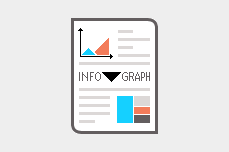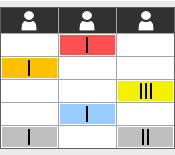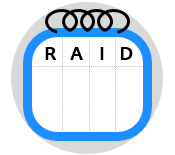
Variants include Project Issue Management and Project Log.
Throughout the course of any project’s lifecycle, many things may arise along the way that can affect the project’s ultimate outcome and timeline. Factors such as material shortages and supplier-related issues have the potential to negatively impact the project, potentially resulting in a failure to deliver the project’s intended outcomes. An effective approach involves the creation of a log, and this is what we are going to cover in this article.
A RAID Log is a project management tool that is used to store several project information in one place. It serves as a central repository for managing and monitoring Risks, Assumptions, Issues, and Dependencies related to a given project. This document allows the project manager and team members to keep track of the project, serving as a single reference point during regular project meetings and for audit purposes.
The act of logging project details using the RAID log keeps the project organized and on track. It makes the information easier to store and retrieve rather than keeping everything on bits of paper or in one’s head. This gives confidence to all project stakeholders that the project is under control and that it is being constantly monitored. Additionally, this practice enables senior management to become actively involved and to provide support as necessary when addressing project-related risks and issues.
Four Key Areas
The RAID log focuses primarily on four key project areas, which are Risks, Assumptions, Issues and Dependencies.
A Risk is something that will have a negative impact on the project if it happens. It refers to the combined likelihood that an event will occur and its potential impact on the project. An example of a project risk is the potential shortage of essential staff, which could lead to project delays. A risk is often evaluated by its Risk Priority Numbers (RPN), obtained by multiplying the likelihood by the impact.
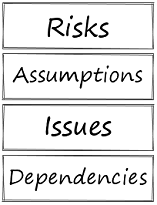
Assumptions are events and conditions expected to happen during the lifecycle of the project. An example of a project assumption is that the project team will have an uninterrupted access to essential systems and resources. Similarly, it may involve the continuous availability of staff from a specific department until the project is completed. An assumption has the potential to turn into a risk if it negatively impacts the project’s deliverability.
Project Issues are unanticipated incidents that cause the project to become out of alignment. These issues are typically risks that have already happened and may affect the project set objectives, costs, or scheduling. An illustrative example might be a security breach resulting in unauthorized data access or the loss of critical information. Failure to manage project issues may result in a poor delivery of the project, or even project failure.
Dependencies are those activities which need to start or be completed in order for the project to proceed as planned. These dependencies may arise during the project execution and need to be logged as soon as they are noticed. For instance, the installation of software should precede the training of personnel in its use. Another example is getting the green light from regulatory agencies for building a new medical facility is a crucial step before construction can start.
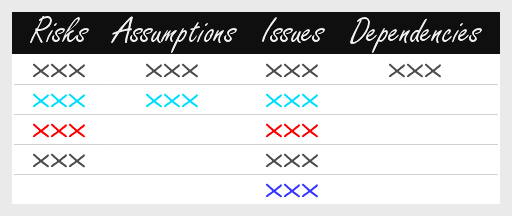

In certain contexts, the ‘D’ in the RAID acronym may refer to the Decisions that should be made throughout the project’s duration in order to achieve the project goals.
Active management of RAID log elements is an important responsibility expected of project managers. This will empower them to take necessary actions to ensure the successful execution of the project. A good practice is to create a RAID log at the beginning of each project, then regularly review and update it as necessary during regular project meetings.
Example
The following is an example of a RAID log summarizing the details of a supply chain project.



A RAID Log can be created simply using a spreadsheet, allocating separate tabs for each of the four primary categories. One of the simplest ways to track the project details is to use this RAID log template.
Wrapping Up
Using a RAID log keeps your project organized and helps tracking everything happening in your project. This will ensure staying on schedule, meeting your goals, and avoiding unexpected surprises on your way. Additionally, this practice increases stakeholder confidence in project control and monitoring while enables senior management to become actively involved to provide support as necessary.
Other Formats
Do you want to use the slides in your training courses?

RAID Log Training Material – $14.85
Related Articles
Related Templates


